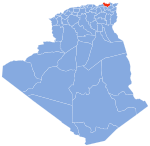world.wikisort.org - Algeria
Collo (Arabic: القل, romanized: al-Qull) was an ancient Roman– a city of the Ottoman empire and Berber. Located in the northern Skikda Province, Algeria. It was the capital and one of three municipalities of Collo District, and a Catholic titular episcopal see under its Roman name Chullu. In 1998, it had a population of 27,800.[1]
Collo
القل | |
|---|---|
City and Common | |
 Collo | |
 Location in Skikda Province | |
 Collo Location in Algeria | |
| Coordinates: 37°0′20″N 6°33′37″E | |
| Country | |
| Province | Skikda |
| District | Collo |
| APC | 2012–2017 |
| Government | |
| • Type | Municipality |
| • Mayor | Djamel Eddin Ghemired |
| Area | |
| • Total | 9 sq mi (24 km2) |
| Population (2008) | |
| • Total | 35,682 |
| • Density | 3,900/sq mi (1,500/km2) |
| Time zone | UTC+1 (CET) |
| Postal code | 21002 |
| ISO 3166 code | CP |
History
In Roman times, Collo was a city in the province of Numidia, called Chullu. At the joint Conference of Carthage (411) that brought together Catholic and Donatist bishops of Roman Africa, Chullu was represented by the Catholic bishop Victor and the Donatist Fidentius.[2][3][4]
In 1282, king Peter III of Aragon led an expedition to Collo, in proclaimed support of a rebellion against the ruler of Tunis. The rebellion had collapsed before Peter arrived, but he kept his army there for several weeks until, in the wake of the Sicilian Vespers, envoys from Sicily came to Collo to offer him its throne. The resulting war continued until 1301.
Geography
Collo has a total area of 9 square miles (23 km2). The city is distinguished by its containing of a mountain range, the most prominent of which are el Goufi 3,881 ft (1,183 m), Sidi Achour 1,771 ft (540 m), and the Tars Mountains. It is known for its various beaches and tourist attractions.
Climate
Collo's climate is classified as warm and temperate. The rain falls mostly in the winter, with relatively little rain in the summer. According to the Köppen Climate Classification system, this climate is classified as "Csa". The average annual temperature is 63.1 °F (17.3 °C), and precipitation is about 32.32 in (821 mm) per year.[5]
| Climate data for Collo, Skikda (1991-2021 normals) | |||||||||||||
|---|---|---|---|---|---|---|---|---|---|---|---|---|---|
| Month | Jan | Feb | Mar | Apr | May | Jun | Jul | Aug | Sep | Oct | Nov | Dec | Year |
| Average high °F (°C) | 56.6 (13.7) |
56.9 (13.8) |
61.8 (16.6) |
66.1 (18.9) |
72.2 (22.3) |
80.4 (26.9) |
87 (31) |
87.7 (30.9) |
80.8 (27.1) |
75 (24) |
64.6 (18.1) |
58.7 (14.8) |
70.7 (21.5) |
| Daily mean °F (°C) | 50 (10) |
49.9 (9.9) |
53.9 (12.2) |
58.3 (14.6) |
64.4 (18.0) |
78.1 (25.6) |
78.1 (25.6) |
78.7 (25.9) |
73.3 (22.9) |
67.5 (19.7) |
58 (14) |
52.3 (11.3) |
63.5 (17.5) |
| Average low °F (°C) | 43.9 (6.6) |
43.3 (6.3) |
46.6 (8.1) |
50.8 (10.4) |
56.8 (13.8) |
69.6 (20.9) |
69.6 (20.9) |
70.8 (21.6) |
66.9 (19.4) |
61.2 (16.2) |
52.2 (11.2) |
46.4 (8.0) |
56.5 (13.6) |
| Average precipitation inches (mm) | 4.4 (112) |
3.9 (99) |
3.2 (82) |
2.9 (73) |
2.0 (51) |
0.6 (14) |
0.1 (3) |
0.5 (12) |
2.0 (52) |
3.2 (82) |
4.8 (122) |
4.7 (119) |
32.3 (821) |
| Average precipitation days | 10 | 9 | 8 | 8 | 5 | 2 | 1 | 2 | 6 | 8 | 11 | 10 | 80 |
| Average relative humidity (%) | 80 | 78 | 78 | 78 | 76 | 69 | 64 | 65 | 71 | 75 | 77 | 79 | 74 |
| Mean daily sunshine hours | 6.2 | 6.8 | 8.0 | 9.2 | 10.5 | 11.9 | 12.3 | 11.3 | 9.5 | 8.2 | 6.8 | 6.2 | 8.9 |
| Source: climate-data.org[5] | |||||||||||||
Demographics
| Year | 1901 | 1954 | 1966 | 1977 | 1987 | 1998 | 2008 |
|---|---|---|---|---|---|---|---|
| Population | 3,300 | 7,000 | 10,800 | 12,408 | 21,100 | 27,774 | 29,354 |
Titular bishopric
In 1833, the Roman diocese was nominally revived as a titular see of the lowest (episcopal) rank. So far, it had four incumbents:
- Marc Lacroix, O.M.I. (1968.10.25 – 1970.11.24)
- Joseph Edra Ukpo (later Archbishop) (1971.04.24 – 1973.03.01)
- Franco Mulakkal (2009.01.17 – 2013.06.13)
- Varghese Thottamkara, Lazarists (C.M.) (2013.06.28 – present)
See also
- European enclaves in North Africa before 1830
References
- populstat.info Archived March 3, 2016, at the Wayback Machine
- Stefano Antonio Morcelli, Africa christiana, Volume I, Brescia 1816, p. 149
- A. Berthier, v. Cullu in Dictionnaire d'Histoire et de Géographie ecclésiastiques, vol. XIII, Parigi 1956, coll. 1103–1104
- J. Mesnage L'Afrique chrétienne, Paris 1912, pp. 274–275
- "Collo climate: Average Temperature, weather by month, Collo water temperature - Climate-Data.org". en.climate-data.org. Archived from the original on 18 June 2022. Retrieved 18 June 2022.
- "Collo (Collo, Skikda, Algeria) - Population Statistics, Charts, Map, Location, Weather and Web Information". www.citypopulation.de. Archived from the original on 20 June 2019. Retrieved 18 June 2022.
Sources and external links
Другой контент может иметь иную лицензию. Перед использованием материалов сайта WikiSort.org внимательно изучите правила лицензирования конкретных элементов наполнения сайта.
WikiSort.org - проект по пересортировке и дополнению контента Википедии
